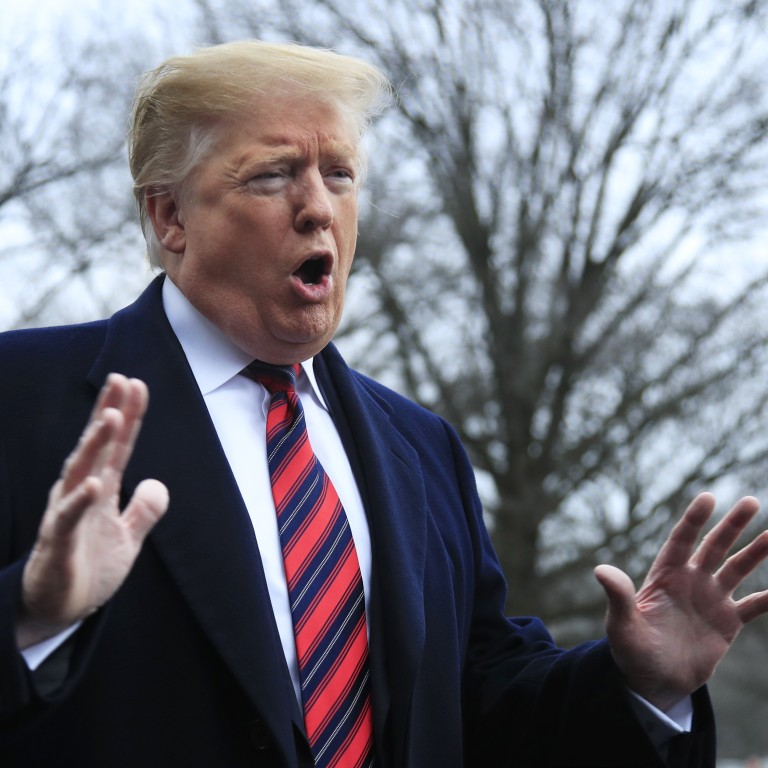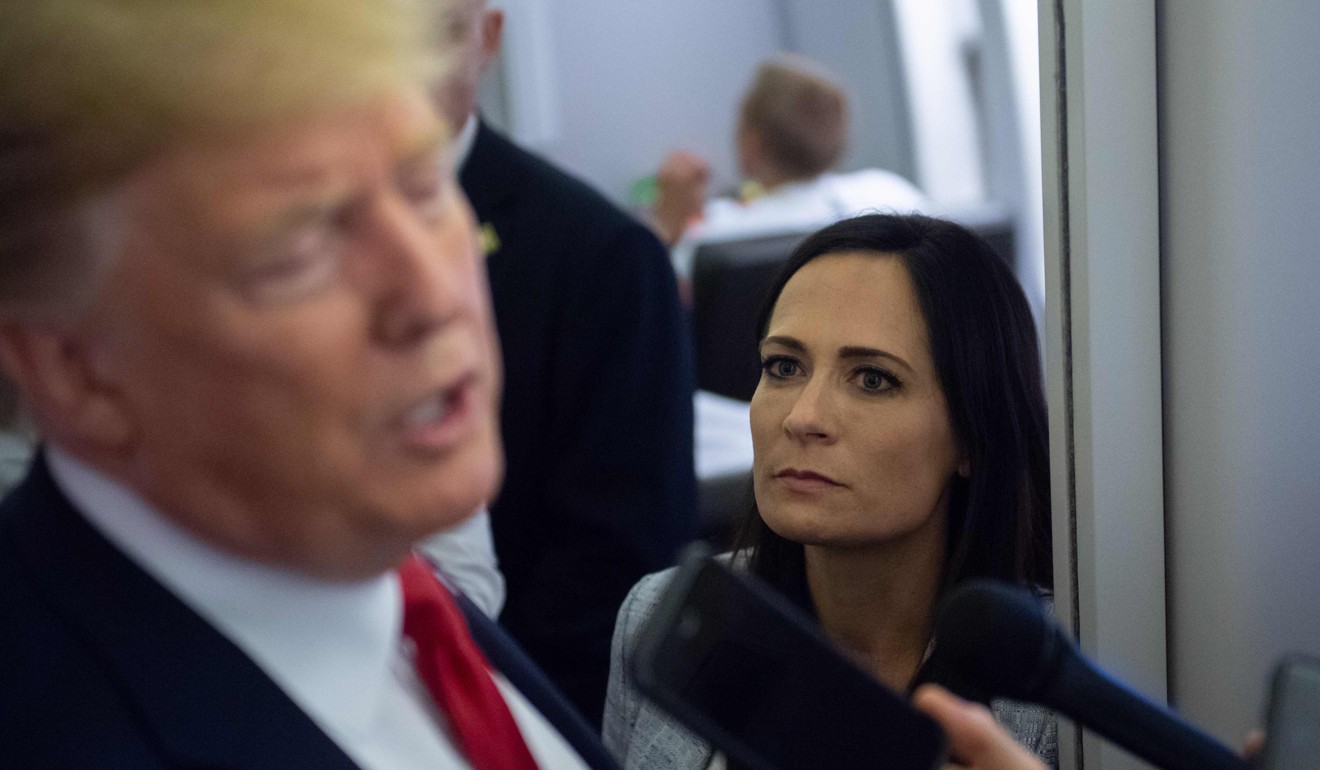
Donald Trump has a favourite number when making big claims: 10,000
- US president has used figure for everything from crowd sizes and captured IS fighters to stock market gains
- Depending on the claim, the number could be accurate, a wild guess, or sometimes just plain wrong
When US President Donald Trump wants to convey that something is a big deal, he often reaches for the same big number: 10,000.
He says it is the number of points the Dow Jones Industrial Average would be up had the Federal Reserve not raised interest rates. It is the number of people attending his rallies – or the number forced to wait outside because they could not get in.
It is also the number of jobs a company plans to create, the headcount of captured Islamic State fighters, the number of migrants in a caravan headed to the US and the Allied casualty count on D-Day.
Sometimes the number is accurate. Other times, it is a wild guess – or wildly wrong.
Trump on Wednesday predicted the Dow would be up – another 10,000 points – if he had not embarked on a trade war with China.
“If I wanted to do nothing with China, my stock market – our stock market – would be 10,000 points higher than it is right now,” Trump told reporters in the Oval Office.
That would be a dramatic rise. With the Dow closing at 26,728 on Thursday, another 10,000 points would represent a 37 per cent increase.
From a marketing standpoint, there’s a great reason to use 10,000: it is memorable.
People may not always think big themselves, but they can still get very excited by those who do. People want to believe that something is the biggest and the greatest and the most spectacular
“He uses this round number in particular because it seems big,” said Jonah Berger, marketing professor at the Wharton School of the University of Pennsylvania, which Trump often boasts of attending.
“He wants to convey something is a big problem, or something would be quite different, so he uses a big round number to try and sway his audience,” said Berger, author of Contagious: Why Things Catch On.
Trump has used the number since his 2016 campaign – in speeches, remarks to reporters and one-on-one interviews – but it could take on new significance as he seeks to burnish his record with the approach of the 2020 election.
The president has repeatedly sought to use 10,000 to his political advantage, even when it does not neatly match reality.
Trump refuses to let ‘Alabama hurricane’ claim go
For instance, he said in January that Immigration and Customs Enforcement officers last year removed 10,000 known or suspected gang members whom he described as “horrible people”. The agency actually reported arresting that number but removing 5,872 known or suspected gang members in financial year 2018.
The White House declined to comment on Trump’s use of 10,000.
The president has other verbal habits. He has often cited self-imposed two week deadlines for major announcements.
While Trump is often faulted by fact-checkers for making false statements, his spokeswoman has said journalists take the president’s words too literally.

“I think the president communicates in a way that some people, especially the media, aren’t necessarily comfortable with,” White House press secretary Stephanie Grisham told The Washington Post in a recent interview. “A lot of times they take him so literally. I know people will roll their eyes if I say he was just kidding or was speaking in hypotheticals, but sometimes he is.”
Trump defended his use of what he called “truthful hyperbole” in his 1987 book The Art of the Deal, calling it an “innocent form of exaggeration”.
“People may not always think big themselves, but they can still get very excited by those who do,” Trump wrote. “People want to believe that something is the biggest and the greatest and the most spectacular.”
Wittingly or not, Trump has taken to a number that comes up often in history, religion and culture.
Pentagon approves US$3.6 billion for Trump’s wall and ‘ego’
The army of the Ten Thousand marched against Artaxerxes II of Persia. During the conquest of Mecca, Mohammed was said to have 10,000 soldiers. The King James Bible has dozens of references to 10,000. Minnesota’s nickname is the Land of 10,000 Lakes. A television game show called The $10,000 Pyramid debuted in the US in the early 1970s.
But Trump’s references typically are rooted in current affairs.
The president used the number in July to talk about attendance at a North Carolina rally where his supporters chanted “Send her back!” after he invoked the name of congresswoman Ilhan Omar, a Minnesota Democrat.
“We had thousands and thousands of people that wanted to come, and we said, ‘Please don’t come,’” Trump said. “It held 10,000 people. It was packed. We could’ve sold that arena 10 times.”
Authorities said 8,000 people got into the arena in Greenville, filling it to capacity, according to WITN-TV in North Carolina. About 2,000 were denied entry and between 750 and 1,000 were in an overflow area, the station said, citing police estimates.
In July, Trump used the number to attack former House Speaker Paul Ryan after the Wisconsin Republican was quoted in a book saying the president doesn’t know how government works.
“I remember a day in Wisconsin – a state that I won – where I stood up and made a speech, and then I introduced him and they booed him off the stage – 10,000 people,” Trump told reporters at the White House.
The president appeared to be referring to a December 2016 post-election rally in West Allis, Wisconsin, where he publicly thanked Ryan, who was in the crowd. Audible, but not deafening, boos were heard as Trump tried to quiet his supporters by telling them that Ryan had improved “like a fine wine”.
Iran answers Trump’s taunt about rocket failure with satellite selfie
Then there’s job creation – a Cameron LNG liquefied natural gas export facility in Louisiana or an Intel semiconductor plant in Arizona. In separate statements, Trump said they would each create 10,000 jobs.
Whether Trump’s use of the number is accurate or not, the specificity can bring credibility to the president’s claims, said Manoj Thomas, a behavioural scientist and marketing professor at Cornell University’s SC Johnson College of Business.
“Using a number to quantify a claim – even implausible numbers – makes it more credible because numbers are concrete,” Thomas said.

“Claims without any numbers, for example, ‘The Dow would be much higher if not for the trade war,’ are more difficult for the human mind to instinctively process because the information is abstract and lacks specificity.”
Trump could add even more credibility to his claim by making the number even more specific, Thomas said.
For instance, the professor suggested: “The Dow would be 4,600 points higher if not for the trade war.”

